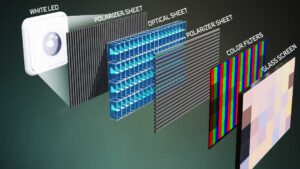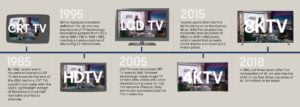Television in Your Home
Television has come a long way since its inception. The first television sets were invented in the early 1900s, and they were a far cry from the televisions we have today. They were black and white, had small screens, and were only able to display a few channels. However, over the years, television sets have become more advanced, with larger screens, higher resolution, and the ability to connect to the internet.
History of TV
an essential part of our lives, but its history spans less than a century. From its humble beginnings in the 1920s to the high-definition displays of today, the story of television is a fascinating one. In this blog post, we will explore the history of television, its evolution, and its impact on society.
The Early Days of Television
- The first electronic television was invented in 1927 by Philo Farnsworth, a 21-year-old inventor from Idaho
- Farnsworth’s invention used a cathode ray tube to display moving images on a screen.
- By 1935, experimental television broadcasts were being transmitted in the United States, and by the end of the decade, television sets were available for purchase by consumers.

Television in the 1940s and 1950s – Display
- Television became more popular in the 1940s and 1950s, with the introduction of commercial broadcasting.
- The first commercial television station, WNBT, went on the air in New York City in 1941.
- By the end of the decade, there were over 100 commercial television stations broadcasting across the United States
- The 1950s were the golden age of television, with the introduction of popular shows like “I Love Lucy,” “The Honeymooners,” and “The Ed Sullivan Show.”
- Television quickly became the dominant form of entertainment, and families across the country gathered around their television sets to watch their favorite shows.
Television in the 1960s and 1970s – Cable TV
- In the 1960s, television underwent significant changes. Color television became more prevalent, and programming became more diverse. The 1960s saw the introduction of iconic shows like “Star Trek” and “The Twilight Zone,” as well as the rise of news programs like “60 Minutes” and “ABC World News Tonight.
- “The 1970s brought further changes to television, with the introduction of cable television and the rise of made-for-television movies.
- Cable television offered viewers a wider range of programming options, and the introduction of the VCR made it possible for viewers to record and watch their favorite shows at their convenience.
Television in the 1980s and 1990s – Addition to TV
- The 1980s saw the introduction of new technologies like satellite television and remote control.
- Cable television continued to grow in popularity, and new channels like MTV and CNN changed the way we consumed news and entertainment
- The 1990s brought further changes to television, with the introduction of high-definition displays and digital television. The rise of the internet also had a significant impact on television,
- The following figure presents a technological evolution in the last 30 years
Types of TV
Television has come a long way since its inception, and it has become an essential part of our lives. With technology constantly evolving, there are now numerous options available for TV for home. Choosing the right TV for your home can be a daunting task, so in this blog post, we will explore the different types of TVs available and help you make an informed decision.
LED TVs
- LED TVs are the most common type of TV available today
- These TVs use LED backlighting to illuminate the display, resulting in better image quality, improved color accuracy, and lower energy consumption
- LED TVs are available in a wide range of sizes and are an excellent choice for most home users
- They are also more affordable than other types of TVs, making them an ideal choice for those on a budget.


OLED TVs
- OLED TVs are the next step up from LED TVs. They use organic compounds to produce light, resulting in brighter colors, deeper blacks, and better contrast
- OLED TVs are more expensive than LED TVs, but they offer a significant improvement in image quality. If you are a cinephile or someone who values image quality over price, then an OLED TV is the perfect choice for you.
QLED TVs
- QLED TVs are similar to LED TVs, but they use Quantum Dots to enhance the colors produced
- This technology results in better color accuracy and more vibrant colors than LED TVs.
- QLED TVs are a great choice for those who want the best of both worlds, offering excellent image quality at a more affordable price point than OLED TVs.

Smart TVs
Smart TVs are a relatively new addition to the market, and they come with built-in Wi-Fi and internet connectivity. These TVs allow you to stream content directly from the internet, such as Netflix, Amazon Prime, and Hulu, without the need for a separate streaming device. Smart TVs also offer a wide range of other features, such as web browsing, social media integration, and voice control. If you are someone who loves to binge-watch TV shows and movies, then a smart TV is an excellent choice for you.

Which TV is better for your Home
- Choosing the best TV for your home can depend on a few factors, including your budget, the size of the room where you’ll be watching TV, and the features you’re looking for
- Here are some things to consider when selecting the best TV for your home:
Screen size:
- The size of your TV should depend on the size of your room and how far you’ll be sitting from the screen.
- A general rule of thumb is to choose a TV with a screen size that is half the distance from the screen to the couch. So, if you’re sitting 8 feet away, a 40-inch TV would be ideal.
Resolution:
- The resolution of your TV refers to the number of pixels on the screen. The higher the resolution, the sharper and more detailed the picture will be.
- The most common resolutions are 1080p and 4K. 4K TVs offer four times the resolution of a 1080p TV and are ideal for larger screens.
Refresh rate:
- The refresh rate of a TV refers to how many times per second the screen is refreshed.
- A higher refresh rate can reduce motion blur and make fast-moving scenes look smoother. Look for a TV with a refresh rate of at least 60Hz.
Smart TV features:
- Smart TVs have built-in internet connectivity, allowing you to stream content from popular services like Netflix and Hulu, as well as browse the web and access social media.
- Consider whether you want these features in your TV.
Brand and price:
- Different TV brands offer different features, and prices can vary widely.
- Popular brands include Samsung, LG, Sony, and Vizio.
- Consider your budget and research the features and performance of different models before making a purchase.
Overall, the best TV for your home will depend on your personal preferences and budget. However, some popular options to consider include the Samsung Q90T, LG CX OLED, and Sony X950H. These models offer a range of features, including high resolution, excellent picture quality, and smart TV functionality.

